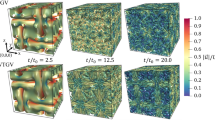Abstract
Modelling turbulence is essential in the chemical and bioprocess industry due to the mixing it creates. In the past, engineers have used two-equation Reynolds Averaged Navier–Stokes (RANS) k –\(\epsilon \) model due to its economical nature; however, it lacks accuracy; whereas direct numerical simulation (DNS) is computationally expensive. Large eddy simulation (LES) turbulence model provides a bridge between the above two models as it resolves the larger scales and models the smaller universal scales of motion. The finite element method (FEM) has become popular in computational mechanics due to the ease with which it can handle unstructured meshes (as opposed to the finite difference method) and the ease in obtaining higher order accurate schemes (through the use of higher order shape functions) as compared to finite volume method. Although there is some work on the solution of LES turbulence model using FEM in the literature, there is a lack of clarity when it comes to the use of different discretisation schemes and solvers. The current work presents a detailed numerical analysis of turbulent flow over a two-dimensional backward-facing step (BFS) using a continuous Galerkin finite element method in an open-source finite element framework—Fluidity, which allows fully unstructured aniostropic adaptive mesh refinement along with the use of distributed parallelism. Fixed and adaptive mesh parallelised simulations are presented for a Reynolds number of 2000 for incompressible flow. The use of different LES models (second-order Smagorinsky and dynamic tensorial), non-linear relaxation parameters and velocity–pressure shape function pairs are thoroughly investigated. The primary reattachment length was calculated and compared against experimental data, finding a good match. Thus, it was concluded that the anisotropy of turbulence, which was captured using this method, can be modelled effectively using an adaptive mesh finite element method.
Access this chapter
Tax calculation will be finalised at checkout
Purchases are for personal use only
Similar content being viewed by others
References
Anwar-ul-Haque, F.A., Yamada, S., Chaudhry, S.R.: Assessment of turbulence models for turbulent flow over backward facing step. Proc. World Congress Eng. 2, 2–7 (2007)
Armaly, B.F., Durst, F., Pereira, J.C.F., Schönung, B.: Experimental and theoretical investigation of backward-facing step flow. J. Fluid Mech. 127, 473–496 (1983). https://doi.org/10.1017/S0022112083002839
Bhutani. G.: Numerical modelling of polydispersed flows using an adaptive-mesh finite element method with application to froth flotation. Ph.D. thesis (2016)
Bull, J.R., Piggott, M.D., Pain, C.C.: A finite element LES methodology for anisotropic inhomogeneous meshes. In ICHMT Digital Library Online. Begel House Inc. (2012). https://doi.org/10.1615/ICHMT.2012.ProcSevIntSympTurbHeatTransfPal.1560
Bull, J.R.: Turbulence models with adaptive meshing for industrial CFD. Ph.D. thesis (2013)
Germano, M., Piomelli, U., Moin, P., Cabot, W.H.: A dynamic subgridscale eddy viscosity model. Phys. Fluids A Fluid Dyn. 3(7), 1760–1765 (1991). https://doi.org/10.1063/1.857955
Khan, Z., Bhusare, V.H., Joshi, J.B.: Comparison of turbulence models for bubble column reactors. Chem. Eng. Sci. 164, 34–52 (2017). https://doi.org/10.1016/j.ces.2017.01.023
Ma, T., Lucas, D., Ziegenhein, T., Fröhlich, J., Deen, N.G.: Scale-adaptive simulation of a square cross-sectional bubble column. Chem. Eng. Sci. 131, 101–108 (2015). https://doi.org/10.1016/j.ces.2015.03.047
Mattson, M.D., Mahesh, K.: A one-way coupled, Euler-Lagrangian simulation of bubble coalescence in a turbulent pipe flow. Int. J. Multiphase Flow 40, 68–82 (2012). https://doi.org/10.1016/j.ijmultiphaseflow.2011.11.013
Schäfer, F., Breuer, M., Durst, F.: The dynamics of the transitional flow over a backward-facing step. J. Fluid Mech. 623, 85–119 (2009). https://doi.org/10.1017/S0022112008005235
Author information
Authors and Affiliations
Corresponding author
Editor information
Editors and Affiliations
Rights and permissions
Copyright information
© 2021 The Editor(s) (if applicable) and The Author(s), under exclusive license to Springer Nature Singapore Pte Ltd.
About this paper
Cite this paper
Agarwal, N., Bhutani, G. (2021). Computational Modelling of Turbulent Flows Using an Adaptive Mesh Finite Element Method: A Benchmarking Study. In: Saha, S.K., Mukherjee, M. (eds) Recent Advances in Computational Mechanics and Simulations. Lecture Notes in Mechanical Engineering. Springer, Singapore. https://doi.org/10.1007/978-981-15-8315-5_27
Download citation
DOI: https://doi.org/10.1007/978-981-15-8315-5_27
Published:
Publisher Name: Springer, Singapore
Print ISBN: 978-981-15-8314-8
Online ISBN: 978-981-15-8315-5
eBook Packages: EngineeringEngineering (R0)




